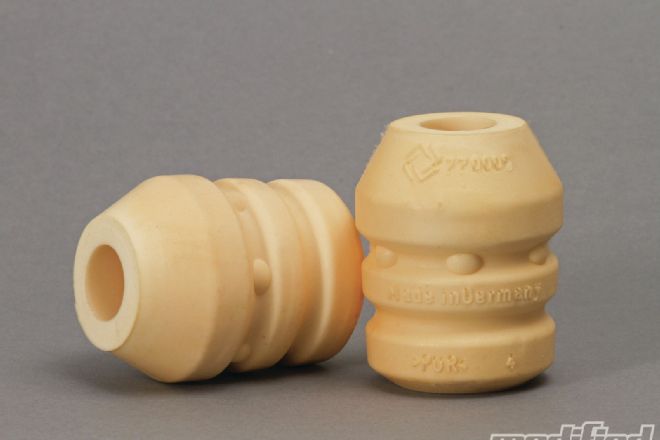When you think about a car’s suspension, chances are the first components that come to mind are shock absorbers and springs, followed by antisway bars and maybe bushings. But if you’re anything like me, those little rubber bumpstops at the top of the shock piston have probably rarely (if ever) caught your attention. For most enthusiasts, about the only time bumpstops even enter the tuning equation is when installing aftermarket shocks and springs, where shortening the OEM bumpstops is sometimes recommended as a quick and dirty way of gaining a little extra suspension travel before the bumpstops come into play.
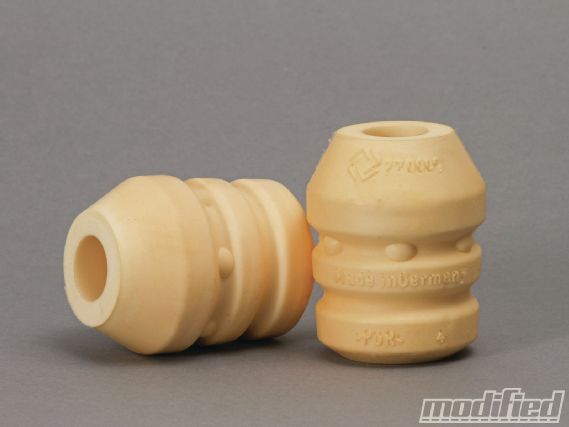 |
The Bump Stops Here - Tech Talk
|
The Bump Stops Here - Tech Talk
Although bumpstops appear to be very simple devices, presumably designed as the last defense against the suspension traveling too far and bottoming out (resulting in infinite spring rate and a very ill-handling vehicle), there’s actually a lot more to them than meets the eye. Rather than attempting to explain the ins and outs of bumpstops based on my own very limited experience (comprised primarily of bouncing off the bumpstops mid-corner and wondering why my car is suddenly understeering like a Buick), we’ve brought in suspension tuning and vehicle dynamics guru Peter Cambridge from PCA Dynamics to shed some light on these mysterious little cylinders of rubbery material.
Formerly the principal chassis development engineer for Prodrive (working on a wide range of projects with OEMs including Alfa Romeo, Aston Martin, Subaru and Mazda) and now an independent consultant, few vehicle dynamics specialists have a broader spectrum of experience fine-tuning suspension components for high-performance road cars. According to Peter, The bumpstop is probably the most misunderstood part of a car’s suspension. Historically, a bumpstop would be a tapered block of rubber used to stop the axle or suspension arm from traveling too far when a wheel hit a bump. The name used in the automotive engineering world now is spring aid,’ and this describes exactly what they do. They aid the spring by adding their own spring rate. They act like a progressive secondary spring and are often mounted on the damper or concentrically with the road spring.
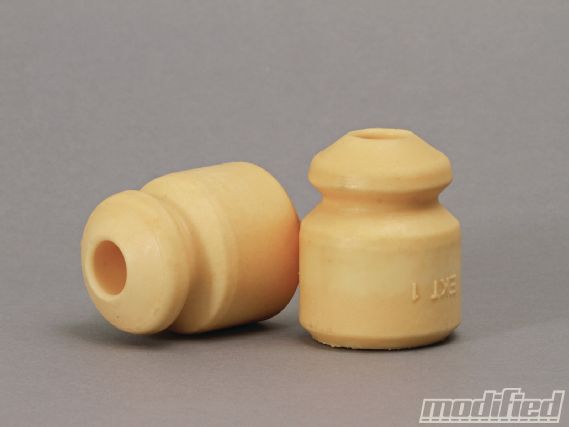 |
The Bump Stops Here - Tech Talk
|
The Bump Stops Here - Tech Talk
As Peter went on to explain to us, although bumpstops ultimately stop the suspension traveling too far when the wheel hits a bump, they have many other functions and effects. Since it aids the spring, a bumpstop can affect how much a car rolls and pitches. It influences the steady-state balance of the car, usually by causing understeer, and it largely controls the balance of the car at the limit. The bumpstop helps the car to ride correctly when it is loaded. Imagine how much the weight changes on the rear axle of a sedan between just the driver being in the vehicle and then the whole family with their camping gear and bikes. Many car manufacturers use the rear bumpstops to add to the main spring rate to support this extra load and maintain a safe handling balance and level ride.
As Peter went on to explain, The bumpstop also has a strong effect on transient handling events, such as turning in to a corner and applying throttle or braking in a bend. Imagine having a car nicely balanced in a long turn, then you get on the gas. The car may already be leaning on the outer bumpstops, and applying gas causes weight to transfer to the rear and it squats a little, using that outside rear bumpstop even more. The balance of the car has changed and it starts to drift great! Maybe it doesn’t drift enough, so a longer or stiffer bumpstop could be put in the rear. If it drifts too much, then a shorter or softer one may be required.
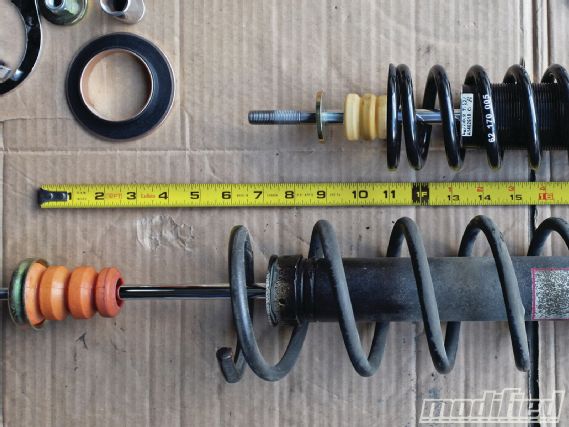 |
The larger and more tapered OEM bumpstop on our RX-8 (bottom) no doubt provides a more gradual transition onto the stop and a more progressive spring rate as it compresses, as compared to the shorter and stiffer bumpstop on the BC Racing coilovers (top).
|
The larger and more tapered OEM bumpstop on our RX-8 (bottom) no doubt provides a more gradual transition onto the stop and a more progressive spring rate as it compresses, as compared to the shorter and stiffer bumpstop on the BC Racing coilovers (top).
As for my reference to bumpstops being made of rubber, Peter explained that this usually isn’t the case anymore. Bumpstops were originally made of rubber. In fact, a few companies still use it, but over 95 percent of vehicles now use a microcellular polyurethane elastomer MPU material. Compared with rubber, MPU parts exhibit excellent durability, have high volume compressibility and don’t set easily. They also maintain their flexibility at low temperature and have consistent performance over time. They are also lighter than a rubber part of the same size.
Peter then went on to say that the key aspect of MPU is its progressive load deflection behavior, where it acts very much like a progressive spring (gaining spring rate as it’s compressed). The more a MPU bumpstop is compressed, the progressively stiffer it gets. So if you compressed it half an inch, it may take 100 pounds of force. To compress it another half an inch may take 500 pounds of force. One would think that a bumpstop could just be made out of a simple block of this material and work well, and this is usually the case with a short one, say 2 inches or less. But longer ones tend to distort as they compress, so they are designed with convolutes to keep them straight. Having these shapes and maintaining a nice progressive rate is not easy and a lot of design, prototyping and testing goes into them.
When I asked Peter about trimming the OEM bumpstops as part of installing aftermarket shocks and lowering springs, here’s what he had to say on the subject: Many aftermarket spring kits and some coilovers require the OEM bumpstop top be used. If the car is lowered significantly, the bumpstops may be in contact all the time. This is likely to make the car understeer a lot and also ride really hard. It is sometimes recommended to shorten them to give some clearance. There are a few things to be aware of doing this. There will be less material, so when it is fully compressed it will be shorter than it was designed to be. The wheel will travel further into jounce or compression, which may cause tire clearance issues. Joints will be asked to go through a larger arc and may neck out. The bumpstops are usually tapered with a very soft nose’ on them. This means when they first make contact you hardly feel them and loads increase gently. If the nose is cut off, they can come in hard with a much stiffer rate. You can feel it and it may affect the handling, especially hitting a bump in a turn. If at all possible, reduce the length from the other end. That may not be possible if it locates on the top mount or grips on the damper shaft with a smaller inner diameter. In that case, cutting off the nose is the only real option, but the initial rate could be softened by drilling a series of holes around the diameter to allow part of it to collapse easily.
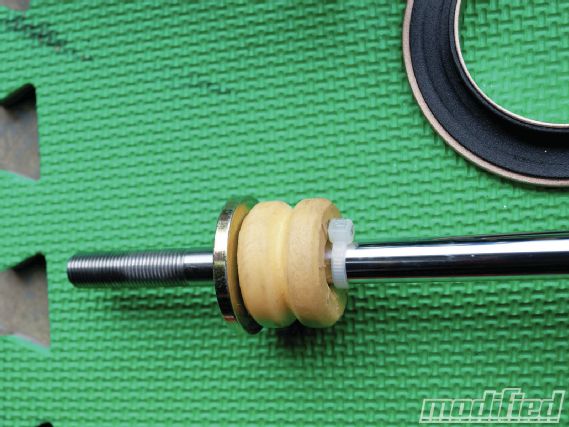 |
We trimmed the BC Racing bumpstops in an effort to gain a little extra suspension travel on the rear of our RX-8, but this may have had the unwanted effect of increasing its initial spring rate, making the transition from main spring to bumpstop harsher.
|
We trimmed the BC Racing bumpstops in an effort to gain a little extra suspension travel on the rear of our RX-8, but this may have had the unwanted effect of increasing its initial spring rate, making the transition from main spring to bumpstop harsher.
As for bumpstop use on race cars, according to Peter, Often they are used truly as just a bumpstop, but the progressive spring rates can be used to help cars when they are riding the curbs or jumping them (as is often seen). In a controlled racing formula like a spec or one-make series where every car must use the same shocks and springs, the bumpstop becomes the one tunable spring on the car. It could even be in contact at ride height if a long enough bumpstop is used or the main springs are short enough. Bear in mind that the rate will be rising steeply into compression but will be dropping off into rebound, so the car is likely to roll up a lot on the inside rather than just down on the outside.
So as you can see, the simple bumpstop is far more than just a backstop designed to prevent the suspension from bottoming out. It’s actually a powerful tuning tool, since they not only stop bumps (as their name implies) but they also affect many aspects of a vehicle’s ride and handling behavior. As Peter put it, Try to think of them as spring aids’, which is what they do!
Since it aids the spring, a bumpstop can affect how much a car rolls and pitches. It influences the steady-state balance of the car, and it largely controls the balance of the car at the limit.
The bumpstop also has a strong effect on transient handling events, such as turning in to a corner and applying throttle or braking in a bend.
Sourcebox
Peter Cambridge
PCA Dynamics
pcadynamics.com

